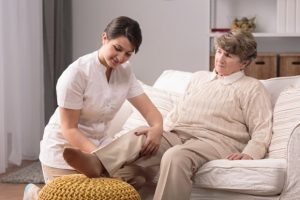
While scientists can’t say for certain what causes more joint pain during the winter, there are some possible explanations, including changes in air pressure. Many people complain that their pain is worse when it is damp or rainy, windy or cold outside. However, experts say that it is actually barometric pressure that seems to be affecting a lot of people. So what exactly is barometric pressure? Simply put, it is the weight of the atmosphere around us.
Tissues surround our joints, almost like a balloon, but high barometric pressure can push against the body from the outside and prevent tissues from expanding. The problem is that the barometric pressure usually drops just before bad weather occurs and this lower air pressure, which does allow the tissues to expand, can put pressure on joints.
Other theories include the fact that our nerve endings become more sensitive due to colder temperatures, which of course can make many of us more sensitive to pain, and some people suffer from poor blood circulation leading to sensations of cold. Our body does work hard in the winter to keep our vital organs warmer. This takes blood supply away from other parts of the body and may lead to stiffer and more painful joints.
There are ways to winter-proof your joints – steps that could lessen the stiffness and pain during the long, cold season.
Exercise: A lack of exercise can increase pain, so incorporating exercise into your routine can greatly reduce it. Additionally, exercise increases blood circulation, so it has longer lasting effects on joint pain, even after you’re done moving. Lastly, exercise keeps muscles strong, which is important for those with arthritic pain, as it will keep joints together.
Eat a balanced diet: Diet also plays a role in joint pain. The foods we eat work to keep our bones and muscles strong, so enjoying a balanced meal of fruits, vegetables, grains, and protein can go a long way. Furthermore, many vitamins fight off inflammation and can work as natural anti-inflammatories. Although it’s important to eat well all year round, it’s especially important during the winter.
Lose weight: Diet and exercise become important because data shows that excess weight puts a lot of strain on our joints. A 2013 study published in the Journal of the American Medical Association (JAMA) showed that there was a significant improvement in people with knee arthritis due to weight loss.
Stay hydrated: Drinking plenty of water is important since most of the body is made up of water. Staying hydrated can help keep the cartilage between the joints lubricated and reduce friction. Friction is something that leads to pain.
Dress appropriately: When it is cold outside, dress warmly. If you like to wear dresses and skirts, consider tights or leggings with them. Also invest in a good set of warm gloves for your hands.
Layer up: Adding layers can make a big difference, so think about wearing two shirts or a shirt and sweater under your coat. You can also layer your mittens or gloves, and even your socks.
Wear knee supports: Depending on the kind of support you need, your doctor can recommend proper knee support to help keep your knee stable.
Go for physiotherapy: In situations where pain level is high, a physiotherapist can help ease you into movements and guide you in working your way up gradually, building strength. It’s important that some people be closely monitored when doing any kind of exercises.
Get a massage: Sometimes the pain in a joint involves the muscles as well, so a massage can help soothe the discomfort. Studies show getting a one-hour massage once a week for at least eight weeks can reduce pain for many people.
Opt for warm water: Swimming in a heated pool is not just good exercise – it has been known to soothe the joints. A warm bath can also be helpful.
Stay safe: When winter weather hits, it can turn icy outside, so be sure to protect yourself from more damage by wearing supportive shoes that have good tread on them. Be observant and avoid walking on any surfaces that look slick.
Try needles: Many people who suffer from joint pain have reported relief following acupuncture treatment. Some people find the treatments relaxing and feel healthier in a general sense.
While we have already mentioned how important a balanced diet is, it can be hard for some people to get enough Omega 3. Supplementing with fish oil is an option. Omega 3 fatty acids are known to help reduce inflammation and are encouraged by the Arthritis Foundation. Studies are ongoing, but some suggest that vitamin D is also good for the joints. Research, published in the journal Pain Management last year, suggested that a lack of vitamin D might play a part in how sensitive people are to arthritis pain. It is also important to point out that being deficient in vitamin D puts you at a higher risk for osteoporosis, too.
The tips outlined here are easy to incorporate into most lifestyles and give people the hope that they may be able to move around freely again and actually enjoy winter, despite the cold.
Related: